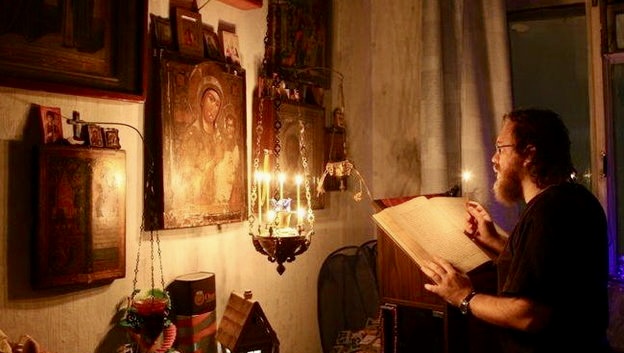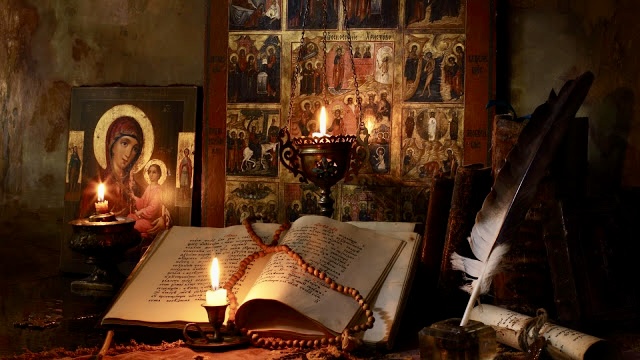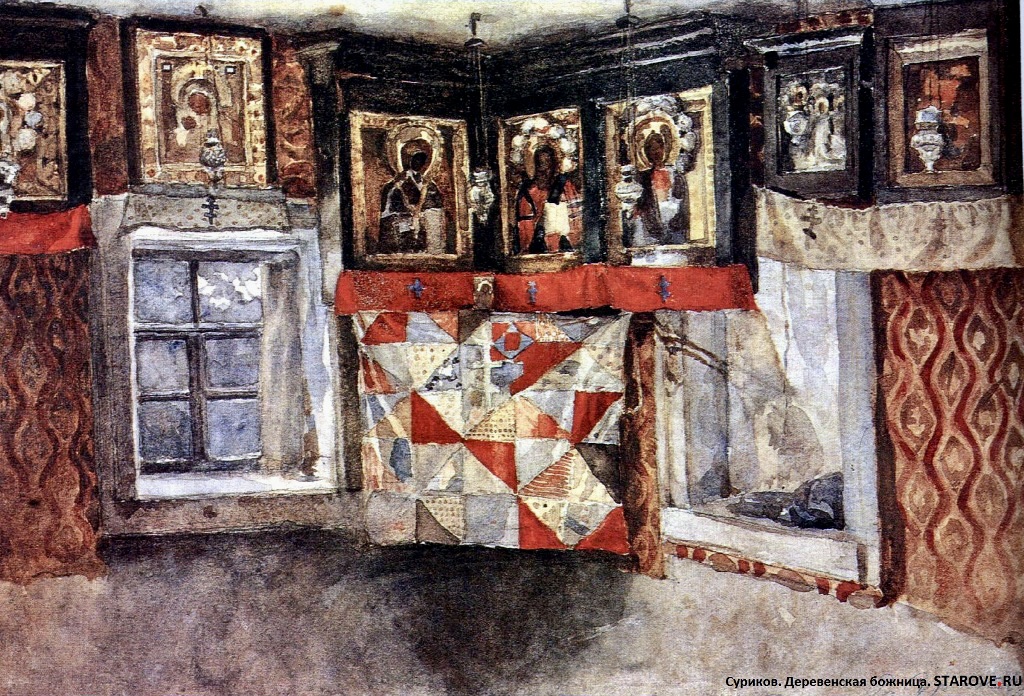 I was very happy that one of our parish-brothers asked for a blessing to chant the canons to the saints of the day during Thursday’s confessions in Nazareth House, with another young brother formatting the canons to St Cyril of Alexandria and St Columba for them to chant together.
I was very happy that one of our parish-brothers asked for a blessing to chant the canons to the saints of the day during Thursday’s confessions in Nazareth House, with another young brother formatting the canons to St Cyril of Alexandria and St Columba for them to chant together.
As I turned to welcome each penitent before their confession, it was wonderful to see four of our parish brothers praying before the shrine containing an icon of the Saviour and the analoy bearing the icons of the icons of the saints of the day, and to hear the refrains of the canons from the other end of the temple.
On our Facebook page, we are always keen on publishing such liturgical canons: cycles of hymns based around the themes of the Biblical Odes, or Canticles, as they are often called in the west.
A good explanation is to be found on orthowiki, so we will simply quote:
“There are nine Biblical Canticles that are chanted at Matins These form the basis of the Canon, a major component of Matins.
The nine Canticles are as follows:
Canticle One – The (First) Song of Moses (Exodus 15:1-19)
Canticle Two – The (Second) Song of Moses (Deuteronomy 32:1-43)
Canticle Three – The Prayer of Hannah (I Kings 2:1-10) KJV: 1+Samuel 2:1-10
Canticle Four – The Prayer of Habakkuk (Habakkuk 3:1-19)
Canticle Five – The Prayer of Isaiah (Isaiah 26:9-20)
Canticle Six – The Prayer of Jonah (Jonah 2:2-9)
Canticle Seven – The Prayer of the Three Holy Children (Daniel 3:26-56)
Canticle Eight – The Song of the Three Holy Children (Daniel 3:57-88)
Canticle Nine – The Song of the Theotokos (the Magnificat: Luke 1:46-55); the Song of Zacharias (the Benedictus Luke 1:68-79)
Originally, these Canticles were chanted in their entirety every day, with a short refrain inserted between each verse. Eventually, short verses (troparia) were composed to replace these refrains, a process traditionally inaugurated by Saint Andrew of Crete.
Gradually over the centuries, the verses of the Biblical Canticles were omitted (except for the Magnificat) and only the composed troparia were read, linked to the original canticles by an Irmos. During Great Lent however, the original Biblical Canticles are still read.
Another Biblical Canticle, the The Song of Simeon (Luke 2:29-32), is either read or sung at Vespers.”
Source: https://orthodoxwiki.org/Biblical_Odes
 The canons – usually, but not always appointed to be chanted during matins – are a great liturgical treasure of our Church, and a great accomplishment of Byzantine hymnography, associated with some great hymnographers: St Andrew of Crete, St John of Damascus, St Joseph the Hymnographer.
The canons – usually, but not always appointed to be chanted during matins – are a great liturgical treasure of our Church, and a great accomplishment of Byzantine hymnography, associated with some great hymnographers: St Andrew of Crete, St John of Damascus, St Joseph the Hymnographer.
The first two names are, of course, particularly associated with two of the great liturgical canons: the Great Canon of Repentance, and the Paschal Canon – both of which have a very important place in Orthodox liturgico-spiritual life.
Other canons, which we know particularly well are the Canon of Preparation for Holy Communion, the Penitential Canon included in most Slavic type prayerbooks, and the “three canons”, chanted as part of preparation for Holy Communion in the East Slavic tradition: the Supplicatory Canon to the Saviour (O Sweet/Sweetest Jesus, in the Old and New Rites respectively), the Small Supplicatory Canon to the Mother of God), and the Small Supplicatory Canon to the Guardian Angel).
Current East Slavic praxis tends not to know the Greater Supplicatory Canon to the Mother of God (not a standard part of liturgical tradition in the centuries of the spiritual formation of Rus) known and loved in the Greek world, and the Greater Supplicatory Canon to the Guardian Angel, to be found in Slavic Old Rite prayerbooks.
Pre-Nikonian Psalters contained the canons for the departed, for those who give us alms, and to St Nicholas – so these were, at one time a common component in the prayer-life of the literate.
The brothers of our parish who use the Old Orthodox Prayerbook (from the ROCOR Old Rite parish in Erie, Pennsylvania), have expressed their appreciation for the canon for the sick, largely unknown by the faithful, today.
Supplication to St Varus, for those who have died without Holy Baptism made the canon to the Great-Martyr popular in Russia, Belorus and Ukraine, and similarly the canon to St Paisius for those who have died without repentance. Recourse to both of these saints was reflected by the popularity of cast icons, particularly among Old Believers.
Over the centuries after the reforms of Patriarch Nikon, the growing popularity of akathist hymns (of varying, and sometimes dubious quality) largely supplanted the chanting of canons by many believers, but it is firstly to the canons that we should turn for intercessory prayer and supplication, rather than akathist hymns, as the canons are the liturgical prayers and hymns of the Church – not para-liturgical or optional extras. We should remember that only one akathist hymn is appointed to be chanted liturgically: that to the Mother of God, by St Romanos the Melodist. Conversely, the canons, are part of the sanctified liturgical prayer of the Church… so I would always encourage parishioners to pray the canons first, with the akathist as an extra though still valuable offering.
The faithful would greatly benefit by including the canons in their day-to-day prayer-life, particularly for Great Feasts of the Lord and the Mother of God, and for the feasts of our major saints, as well as regularly praying the various canons for the sick and the departed.
This is easy for those praying in Slavonic, as the Kanonik (according both Old and New Rite texts) is freely available as a unified collection of texts, in print and electronically, but with the wealth of liturgical material available on-line, a little searching will lead those praying in English to a wealth of resources – especially in the monthly menaia to be found online at the ponomar project (https://www.ponomar.net) and at st-sergius.org (http://www.st-sergius.org/services/pent/100.pdf), both also having texts in Slavonic.
Following simple custom, a canon may be chanted just before the end of our morning or evening prayer-rule, followed by “It is Truly Meet” or its festal replacement and just before the usual dismissal of the prayers. Alternatively canons may chanted ‘alone’ with slightly varying orders available on-line.
Parishioners use a variety of different prayerbooks, and I would recommend that British parishioners in particular ensure that any prayerbook they consider buying contains the canons we use week by week, not just for preparing for communion but as a more regular part of Orthodox prayer.
Additionally, I hope that parishioners make the most of freely available resources, and assemble their own ‘kanonik’, so that they always have a source of liturgical prayer freely available in our homes, so that we do not spend times of prayer scrolling down the screen of a mobile phone.
As an extremely geographically dispersed community, the canons in our daily prayers can be a source of liturgical and prayerful unity across the miles, as we mark the feasts and seasons in our homes in the cities, towns and villages in which we live.
